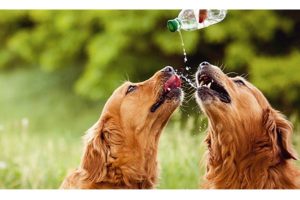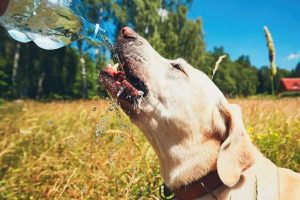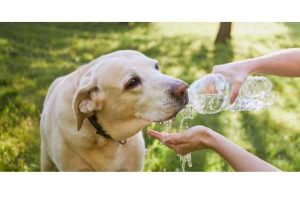Signs of Dehydration in Dogs: How Long Can A Dog Go Without Water
In the realm of pet care, the paramount importance of hydration for dogs is unchallenged. Dogs, being sentient beings, necessitate water to sustain vital bodily functions and maintain optimal health. Understanding the factors that influence a dog’s water requirements and recognizing signs of dehydration in these animals are crucial responsibilities for pet owners.

However, an inquiry arises regarding the duration a dog can survive without access to water. This question warrants investigation as it pertains to ensuring the well-being and welfare of our canine companions. By exploring this topic further, we can provide practical guidance on how to keep dogs adequately hydrated and address concerns related to circumstances where water availability may be limited.
Thus, this article endeavors to examine the duration a dog can go without water while offering valuable insights into safeguarding their hydration needs under diverse conditions.
Key Takeaways
- Factors such as age, size, activity level, and environment can influence how long a dog can go without water.
- Signs of dehydration in dogs include dry gums, sunken eyes, lethargy, excessive panting, loss of appetite, dark urine, thick saliva, and poor skin elasticity.
- It is important to provide fresh water at all times to ensure a dog stays hydrated.
- Tips for ensuring a dog stays hydrated include bringing portable water bowls when traveling, planning frequent breaks during long journeys, making fresh water available in multiple locations, and using flavoring agents if necessary.
Importance of Hydration for Dogs
The maintenance of proper hydration is vital for dogs as it plays a crucial role in various physiological processes, such as thermoregulation, nutrient transportation, and waste elimination. Dogs rely on water intake to regulate their body temperature through panting and sweat gland activity. Additionally, water facilitates the transport of nutrients throughout their bodies and aids in the elimination of waste products. Providing access to clean and fresh water is essential for meeting these hydration needs.

Common sources of water for dogs include tap water, bottled water, and filtered water. Tap water is readily available in most households and generally safe for consumption by dogs. However, it is important to ensure that tap water does not contain any harmful contaminants or additives such as chlorine or fluoride that may be detrimental to canine health. Bottled water can serve as an alternative option but may be more expensive over time. Filtered water can also be used to remove impurities that might affect the dog’s overall well-being.
In conclusion, maintaining proper hydration is essential for the overall health and well-being of dogs. Offering access to clean and fresh drinking water from common sources ensures that they can fulfill their hydration requirements effectively.
Factors that Affect a Dog’s Water Needs
Factors such as temperature, activity level, and diet significantly influence the amount of water a canine requires for optimal hydration. Dogs regulate their body temperature primarily through panting, which increases water loss. Therefore, in hot weather or during intense physical activity, dogs may require more water to compensate for increased fluid loss.

Additionally, the type of diet a dog consumes can impact its water needs. Dry kibble diets contain less moisture compared to wet or raw food diets, requiring dogs to drink more water to stay hydrated.
Moreover, factors like age and size also play a role in determining a dog’s water requirements. Puppies and lactating females generally need more water than adult dogs due to higher metabolic rates and increased fluid demands associated with growth and milk production.
Common sources of drinking water for dogs include bowls filled by their owners or automatic dispensers designed specifically for pets’ hydration needs.
Signs of Dehydration in Dogs
Signs indicating a canine’s insufficient hydration include dry gums, sunken eyes, and lethargy. Dehydration prevention is crucial in ensuring the well-being of dogs as it can lead to various health risks.
To prevent dehydration in dogs, pet owners should be aware of the following:
- Panting: Excessive panting can indicate that a dog is overheated and dehydrated.
- Loss of appetite: A lack of interest in food may be a sign that a dog is dehydrated.
- Dark urine: Concentrated urine with a strong odor suggests inadequate water intake.
- Thick saliva: Dehydrated dogs may have thick and sticky saliva.
- Poor skin elasticity: Pinching the skin on the back of a dog’s neck and observing how quickly it returns to normal can indicate hydration levels.
Understanding these signs and taking appropriate measures to ensure proper hydration are essential for the overall health and well-being of our furry friends.
How Long Can a Dog Go Without Water?
Interestingly, the duration that a canine can endure in the absence of proper hydration presents a critical concern for pet owners. A dog’s water intake is crucial for maintaining overall health and well-being. Dehydration occurs when there is an inadequate amount of water in the body, leading to various health risks. Dogs rely on water for essential bodily functions such as digestion, temperature regulation, and waste elimination. Without sufficient hydration, dogs may experience symptoms such as dry mouth, lethargy, sunken eyes, and loss of appetite.
Dogs rely on water for essential bodily functions such as digestion, temperature regulation, and waste elimination. Without sufficient hydration, dogs may experience symptoms such as dry mouth, lethargy, sunken eyes, and loss of appetite.
The length of time a dog can go without water depends on several factors including age, size, activity level, and environmental conditions. However, it is generally recommended that dogs have access to fresh water at all times to prevent dehydration and associated health complications.
Tips for Ensuring Your Dog Stays Hydrated
To ensure your canine companion remains properly hydrated, it is essential to implement a few key strategies.
- When traveling with a dog, it is important to bring along portable water bowls and bottles to provide access to clean drinking water at all times.
- Additionally, consider planning frequent breaks during long journeys to allow your dog the opportunity to drink and relieve themselves.
Encouraging your dog to drink more water can be achieved by:
- Making sure fresh water is always available in multiple locations around the house.
- Some dogs prefer running water, so investing in a pet fountain may also help increase their water intake.
- Adding flavoring agents like low-sodium chicken broth or frozen fruit cubes can make water more enticing for picky drinkers.
Regular exercise and feeding a moisture-rich diet can also contribute to keeping your dog properly hydrated.
By following these tips, you can ensure that your furry friend stays well-hydrated even when on the go.
See also:
Frequently Asked Questions
Can I give my dog other liquids besides water to keep them hydrated?
Alternatives to water for dog hydration should be used sparingly, as water is essential for dogs’ health. While small amounts of low-sodium chicken broth or diluted fruit juices may be given, water remains the best choice due to its vital role in maintaining proper bodily functions and preventing dehydration.
How often should I refill my dog’s water bowl?
To ensure your dog stays hydrated, refill their water bowl regularly. Additionally, teaching them to drink from a water fountain can be beneficial. For picky dogs, try adding flavors or using a larger bowl to encourage increased water consumption.
Are there any specific water bowls or containers that are better for keeping my dog hydrated?
When considering dog water bowls and portable water containers, it is important to choose options that are designed to keep dogs hydrated. Features such as spill-proof designs and easy accessibility can help serve the needs of dogs and their owners.
Can a dog survive solely on wet food without needing water?
While the adage “you can lead a horse to water, but you can’t make it drink” holds true, wet food alone cannot replace water for dogs. Wet food does provide some hydration, but dogs still require access to fresh water for optimal health and hydration.
Are there any specific breeds or sizes of dogs that are more prone to dehydration?
Certain breeds and sizes of dogs may be more prone to dehydration due to factors such as higher activity levels, longer fur, or predispositions to certain health conditions. Understanding these risk factors can help owners take appropriate measures to prevent dehydration in their pets.
